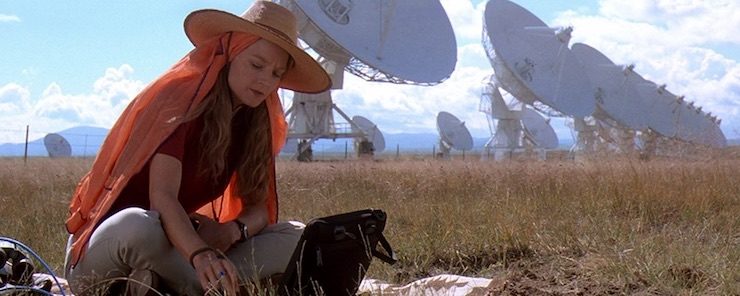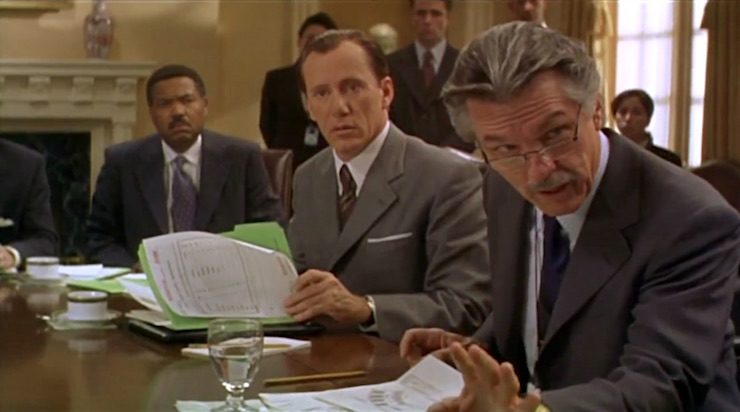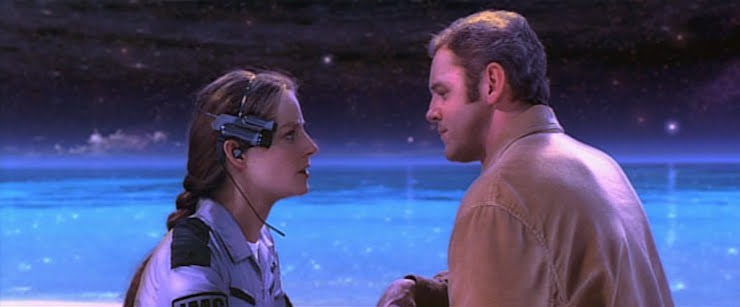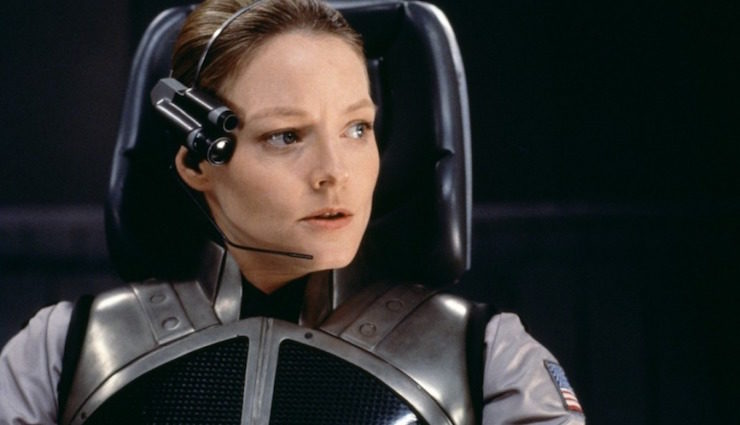Every few years, Hollywood attempts a big movie which deals with big SF ideas. I’m not talking the sort of tiny budget breakout success like Moon (which is great) or the zero budget maximum invention movies like Arq and Synchronicity that pepper Netflix (also pretty great). I’m talking about blockbusters. Every few years we get a blockbuster that attempts to ask big questions in a big way—while avoiding the cliche of running away from something in slow-motion while it explodes. Not that there’s anything wrong with the slowmotionplosion school of movie making.
It’s like every other kind of art in that it tells you two stories. The first is the story the creators set out to relate. The second is the story of the environment and time the art is created within—the larger context of which the movie is a part. That second one is often where the big, difficult, chewy, fun issues live, and it’s interesting to see how those change and shift over time. The first version of Invasion of the Bodysnatchers, for example, is clearly influenced by the “reds under the bed” scare. The second? Watergate all the way down.
That second story is always there, but it’s not always put in the spotlight. But when those big issues are put front and centre—as they are every few years in SF movies—then interesting things happen. That’s where Arrival comes in. Arrival, based on a story by Ted Chiang, has been getting rave reviews. I’m really excited about it and have written about it here before. But, as pre-game if you like, I’ve also been watching the last couple of attempts Hollywood made at this sort of Big Idea movie: Contact and Interstellar. We’ll get to Interstellar in a later piece, but for now its Doctor Arroway’s turn…
Contact is based on Carl Sagan’s novel of the same name. It’s directed by Robert Zemeckis and stars Jodie Foster as Doctor Ellie Arroway. Ellie’s a driven, hyper-focused, and unapologetic scientist absolutely dedicated to the search for extra-terrestrial life. That search costs her respect in her field, eventually her job at the Aricebo Radio Telescope, and almost anything resembling a life outside the work itself. She’s, appropriately given her name, a straight arrow fired directly at one target and absolutely dedicated to hitting her mark.

That’s the first thing that impresses and surprises you about Contact upon re-watching the film. The movie was made 19 years ago and Arroway remains one of the strongest, most interesting female leads mainstream US cinema has produced. She’s a tireless intellectual whose mild emotional suppression is categorically a feature and not a bug. The most emotional moment in the movie is nothing more than Arroway, strapped into an alien machine that may be shaking itself apart, terrified and saying nothing but “Okay to go” over and over. She has no idea what’s about to happen. She has no idea if she’s going to live. She’s exactly where she needs to be.
That level of determination, and the gradual way the film weaves it together with Arroway’s emotional wellbeing reflects a more nuanced approach to writing than films half Contact’s age exhibit. It’s also what stitches the entire movie together. Zemeckis, post-Forrest Gump, was in full CGI-fidget mode and Contact is full of technically audacious shots, most of them centred on Arroway. What’s great is that unlike the endless newsreel showboating of Gump, these shots are surprisingly subtle. There’s a famous, and dizzying, tracking shot through a mirror that’s massively impressive, but the one that really haunts you arrives towards the end of the movie. Mid-interstellar journey, Arroway is given a moment to admire the view and her face as a child (Played by fellow genre MVP Jena Malone) is overlaid on her adult form. It’s a moment that, at the time, was critically derided, but with close to two decades’ distance it’s close to the poetry that Arroway bemoans her own inability to express.
It’s also, interestingly, a resolutely emotional and deeply personal experience that is in no way spiritual. It’s no less powerful for that, though, and Arroway remains one of the very few prominent scientist characters who manages to mesh her training with her emotional responses to events. That single sequence is the point where everything in the movie connects, as it’s a literal and metaphorical vindication and unification of every warring school of thought the film has tangled with up to that point.
The second major way in which Contact impresses is in its pragmatism. The response to the message that Arroway and her team detects is as messy, untidy, and cynical as you’d expect and that gives the film an edge of realism that helps it immensely. The impromptu Burning Man-style festival outside the Very Large Array is an especially nice touch, but it’s the political implications of the message that still feel timely, or even prescient. The initial reveal that the message features an image of Hitler from the Berlin Olympics lends a grimly humorous tone to proceedings as the various observers react around the room and fuels the fundamental caution which colors much of the government’s interactions with the message.
More pertinently to 2016, watching John Hurt’s mercurial Hadden run rings around the world’s governments is an interesting experience. On the one hand it plays like an extended salute to Steve Jobs at his best. On the other, it’s an extended parody of Jobs and his ilk at their worst; Hadden becoming a man who has moved past the needs of terrestrial life, so concerned with leaving a mark that he doesn’t care whether the mark is actually a scar.

Likewise, Tom Skerritt’s excellent Drumlin is both a standard “Evil Boss” and a remarkably grounded, occasionally likable man. One of the film’s best scenes is what turns out to be his final conversation with Arroway. He openly confesses to the political gamesmanship we’ve seen him engaging in and tells Ellie how much he admires her and that in a better world, she’d have won. It’s an almost decpetively subtle scene that’s sympathetic, hateful, honest, funny, and mean all at once. You still sort of want to punch him, but there’s precious little moustache-twirling and Drumlin is always a troublingly understandable antagonist.
The same is true of Matthew McConaughey’s Palmer Joss. A spiritual advisor to the President, Joss is an interesting pit stop on McConaughey’s journey to his current status as an actor. There’s certainly an element of the Good Time King approach that dominated McConaughey’s early work, but there’s also real signs of the troubled depth he’d bring to later roles. Joss isn’t close to the nihilistic prophet Rust Cohle would be on True Detective, but he is within sight of Interstellar’s Coop. The two men share a fingertip-deep comfort with their place in the world, a fundamental need to push the envelope and, when it comes down to it, a selfish streak. We’ll see how Coop deals with his issues in a later piece, but Joss’ key moment here is another one where the film impresses. His reasons for sabotaging Arroway’s chances with the selection committee are multi-layered, self-centred, painfully human, and the antithesis of how Arroway conducts her life. They’re also completely understandable and, again, the film successfully shows conflicting ethical and moral viewpoints that aren’t antagonistic. By some lights, this open-endedness could be seen as noncommittal; by others, it’s that streak of pragmatism appearing once again.
The ending, which is the other element that really annoyed people on release, takes that pragmatism to its logical conclusion. Arroway experiences a journey through the vastness of space, talks to an alien intelligence that uses the form of her late father, and returns only to find that she apparently never left. The eventual reveal that her headset recorded eighteen hours of static shows she clearly didn’t imagine it, but also denies the film the “And then the aliens landed and made us all better” pat ending it sometimes threatens to have. It also—and this is the really brave thing—denies the film closure beyond Ellie Arroway herself. She gets one last conversation with her dad (as the embodiment of her platonic ideal), and even that is coded on multiple levels. It’s sweet but not quite saccharine, honest but still a carefully chosen mask to soften the impact of some difficult news. Arroway has travelled further than any other human but, as she and we both find out, that journey can only ever be a beginning, not a final destination. The echoing of her father’s “small moves” maxim is an elegant acknowledgement of how life-changing the news she’s bringing back will be and loops back around to the Hitler reference at the start to show just how acutely aware our neighbours are of who we are. It also cleverly places the entire movie in context: building the Machine is the single most complicated and expensive project ever undertaken. And for all the debate, the angst, the loss of life and the rigours of Arroway’s journey, it’s still just step one.

All this complexity, and even ambiguity, could be depressing. The exploration of institutionalized sexism certainly is, especially given how accurate the depiction remains almost two decades after release. But that pragmatism, combined with Arroway’s dedication and the film’s even-handed approach makes for a far more successful exploration of first contact than you might think. It’s not perfect (the score in particular feels like it’s wandered in from a low-ebb Disney movie) but Contact remains a high point in Hollywood’s cautious engagement with big-idea SF. It’ll be especially interesting to see how Ellie Arroway informs Arrival’s Doctor Louise Banks; I get the feeling they’d have a lot to talk about.
Alasdair Stuart is a freelancer writer, RPG writer and podcaster. He owns Escape Artists, who publish the short fiction podcasts Escape Pod, Pseudopod, Podcastle, Cast of Wonders, and the magazine Mothership Zeta. He blogs enthusiastically about pop culture, cooking and exercise at Alasdairstuart.com, and tweets @AlasdairStuart.










